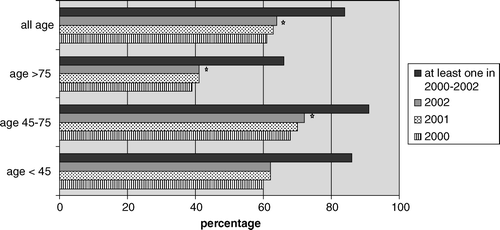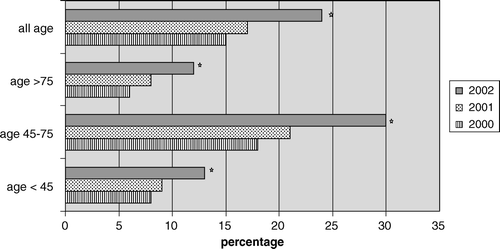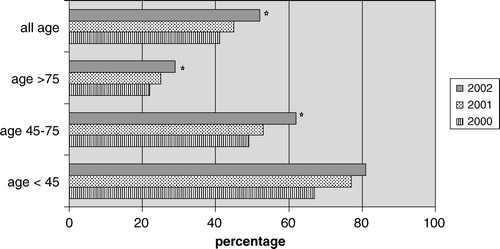Abstract
Objective. This study aims to describe the routine monitoring of lipids and the use of lipid-lowering medicine in people with type 2 diabetes in the period 2000–2002. Material and methods. Data from the National Health Service Registry, the Regional laboratory database and the Danish National Hospital Registry have been used for identification and description of known diabetes in a background population of 649,177 citizens in the County of Aarhus, corresponding to 12% of the total Danish population. All data were collected for the period 1 January 2000 to 31 December 2002. Results. A total of 14,644 people with type 2 diabetes were identified, 52% of whom were men. The mean age was 64 years and the mean duration of diabetes was 7 years. A total of 61% had a minimum of one measurement of total cholesterol in 2000 compared with 64% in 2002. Some 71% of the patients in 2000 compared with 66% in 2002 had a total cholesterol concentration above 5.0 mmol/l. The proportion of people with type 2 diabetes treated with a lipid-lowering drug increased from 15% in 2000 to 24% in 2002. For those who were treated with lipid-lowering medication 33% in 2000 and 42% in 2002 reached currently recommended targets of total cholesterol concentrations. Conclusions. The results of this study provide a realistic picture of the monitoring of cholesterol as part of diabetes care and found a tendency to increased adherence to guidelines. Even so, it seems as if more patients with diabetes could benefit from treatment with lipid-lowering medication.
Individuals with type 2 diabetes have an increased risk of mortality primarily due to cardiovascular disease (CVD) Citation[1], Citation[2]. An important risk factor for development of CVD Citation[3] is dyslipidemia and randomized controlled studies have shown that lipid-lowering treatment reduces the risk of CVD and death Citation[4], Citation[5]. In Denmark, an increasing number of individuals with lipid measurement are registered Citation[6], but it is unknown whether the increasing efforts concerning cholesterol-lowering activities also include type 2 diabetic patients or whether interventions towards lowering cholesterol levels are sufficient.
Clinical guidelines for type 2 diabetes have defined the targets of monitoring lipids and strategic practical interventions have been recommended to accomplish these goals Citation[7]. Furthermore, the guidelines have been disseminated extensively to all general practitioners for many years Citation[8]. However, population-based studies have shown that the recommendations from clinical guidelines are frequently not met Citation[9], Citation[10].
Monitoring lipids and giving sufficient lipid-lowering treatment reduce the risk of CVD and death in patients with type 2 diabetes.
Two-thirds of the patients with type 2 diabetes had cholesterol measurement in 2002.
Two-thirds of the type 2 diabetic patients with total cholesterol >5 mmol/l received no pharmacological treatment in 2002.
Three-fifths of the type 2 diabetic patients treated with a lipid-lowering agent did not reach the recommended target in 2002.
This study aims to describe the routine monitoring of cholesterol and the use of lipid-lowering medicine in type 2 diabetic patients from a large well-defined geographic area in the period from 2000 to 2002.
Material and methods
The background population in this study was 649,177 citizens in the County of Aarhus, corresponding to 12% of the total Danish population.
Identification
The type 2 diabetes population was identified by use of public data files. The identification process was repeated yearly between 1 January 2000 and 31 December 2002 using the following data files:
The National Health Service Registry delivered data from diabetes-related services provided by chiropodists and on prescriptions for anti-diabetic tablets and insulin (anatomical-chemical-therapeutic (ATC) codes A10) distributed from all pharmacies within the county.
The regional laboratory database delivered data on HbA1c. The regional laboratory database system contains data on all blood tests analysed by hospital laboratories within the County of Aarhus at the request of general practices and hospitals. The laboratories collaborate in analysing the blood samples and use identical reference ranges for HbA1c (the reference value was 4.6–6.4%).
A yearly search in the Danish Civil Registration System identified persons as residents or non-residents in the County of Aarhus, or as deceased. Information concerning time of diagnosis was collected from a questionnaire sent to all identified persons and from medical records from hospitals and general practitioners.
Patients were classified as type 2 diabetic patients if they were treated with diet alone, with anti-diabetic tablets or, irrespective of treatment, if they were over 40 years of age at the time of diagnosis. A total of 332 persons treated with insulin were classified as unknown type of diabetes due to unknown time of diagnosis. They are not included in the study.
Monitoring of lipids and treatment with lipid-lowering medications
Data concerning measurements of total cholesterol were collected from the regional laboratory database system. Furthermore, data concerning prescriptions on lipid-lowering medications (ATC codes C10) distributed from all pharmacies within the county were collected from the Danish National Health Services Registry. All data were collected for the period 1 January 2000 to 31 December 2002.
Admission to hospital with myocardial infarction
Data concerning admission to all hospitals with myocardial infarction were collected from the Danish National Hospital Registry for the period 1977–2002. The Danish National Patient Registry contains information about any patient contact with hospital departments in Denmark. A cardiovascular-related diagnosis was defined as ICD10: I21–I23, I24.8, I24.9, I25.2, and ICD8: 410.
Statistics
SPSS version 10.0 was used to perform a descriptive analysis. The population of patients with diabetes was identified first on 1 January 2000 and updated in January 2001 and 2002. For the identified population the proportion with a measurement of cholesterol, the proportion of patients with a total cholesterol <4.5 mmol/l, between 4.5 mmol/l and 5.0 mmol/l, and >5.0 mmol/l and the proportion of type 2 diabetic patients treated with lipid-lowering medication in the following period from 1 January to 31 December was calculated for the years 2000, 2001, and 2002. The McNemar test for paired data was used to evaluate differences between years.
Ethics
The study was approved by the Scientific Ethics Committee in the County of Aarhus and by the Danish Data Protection Agency.
Results
The total number of identified patients with type 2 diabetes was 9136 in 2000, 11,860 in 2001, and 14,644 in 2003. In 2003, there were 52% males in the population. The mean age was 64 years (SD 12.38) and the mean duration of diabetes was 7 years (SD 7.26). Some 12% were treated with insulin, 44% with anti-diabetic tablets, 6% with anti-diabetic tablets combined with insulin, and 39% received no pharmacologic anti-diabetic treatment.
Of all the type 2 diabetic patients, 61% had a minimum of one measurement of total cholesterol in 2000 compared with 64% in 2002 () (McNemar test, p < 0.005). In the group of type 2 diabetic patients diagnosed in 2000 or before, 84% had at least one measurement between 2000 and 2002. shows the proportion of type 2 diabetic patients with and without pharmacologic treatment in relation to age and total cholesterol concentrations. The proportion of patients with total cholesterol >5 mmol/l decreased from 2000 to 2002 (McNemar test, p < 0.001).
Figure 1. Percentage of type 2 diabetes patients with a measurement of total cholesterol in 2000, 2001, or 2002.*Difference between 2000 and 2002, p < 0.05

Table I. Percentage (number) of type 2 diabetic patients without pharmacologic treatment reaching levels of total cholesterol concentrations where treatment is recommended and percentage (number) of type 2 diabetes patients with pharmacologic treatment reaching recommended targets of total cholesterol concentration.
The proportion of type 2 diabetic patients treated with lipid-lowering medication increased from 15% in 2000 to 24% in 2002 () (McNemar test, p < 0.001). Of those treated with lipid-lowering medicine in 2002, 99% had measurement of lipids between 2000 and 2002.
Figure 2. Percentage of type 2 diabetes patients treated with lipid-lowering medication in 2000, 2001, or 2002.*Difference between 2000 and 2002, p < 0.05

In 2002 a total of 1524 (10%) persons had a history of admission due to myocardial infarction. shows that only a total of 41% in 2000 and 52% in 2002 of patients in this group was treated with a lipid-lowering drug (McNemar test, p < 0.001).
Figure 3. Percentage of type 2 diabetes patients with a history of myocardial infarction treated with lipid-lowering medication in 2000, 2001, or 2002.*Difference between 2000 and 2002, p < 0.05

In the group of type 2 diabetic patients who were treated with lipid-lowering medication in 2002 a total of 97% (n = 3,477) were treated with statins, 5% (n = 178) were treated with fibrates, 0.5% (n = 19) patients were treated with resins, and 0.2% (n = 7) were treated with derivatives of nicotinic acid. Combination treatment with more than two different drugs was seen in 3% of the population.
Discussion
In Denmark, most type 2 diabetic patients are cared for by their general practitioner Citation[12]. The Danish College of General Practitioners has published guidelines that have been distributed to all general practitioners for many years. The guidelines recommend measurement of lipids at least once a year and the guidelines valid in 2002 recommend initialization of pharmacologic treatment if non-pharmacologic treatment does not succeeded in lowering total cholesterol below 5 mmol/l within 3–6 months Citation[7]. This study shows that two-thirds of the population had measurement of their cholesterol each year and the majority had had a measurement within a three-year period. A total of 22% were treated with lipid-lowering drugs in 2002. Only 47% of patients admitted for myocardial infarction were treated with lipid-lowering drugs, indicating severe under-treatment according to the guidelines.
Some studies conducted in the late 1990s showed that only 30% of people with type 2 diabetes had had cholesterol measurement – other studies showed that above 50% of people with type 2 diabetes had had cholesterol measurement Citation[13–16]. We found that 64% in 2002 and 84% in 2000–2002 had cholesterol measurement indicating an increased awareness of the importance of control for dyslipidemia.
In our study an increasing number of patients were treated with lipid-lowering medication; however, in the group of patients not receiving any medication, 66% had a level of total cholesterol above 5 mmol/l in 2002. A limitation is that the study is based on register data and includes no information from physicians or patients regarding any kind of lifestyle advice offered or the patients’ attitude to and compliance with pharmacologic treatment. Thus, there may be valid clinical circumstances not apparent from the data that justify not initiating pharmacologic treatment.
Intervention studies have shown that successful reduction of hypercholesterol is possible in most patients Citation[17]. But in this study of routine care the total cholesterol level was reduced to the then recommended targets in 33% of patients being treated with lipid-lowering medicine in 2000 and 42% in 2002, indicating further need to intensify diabetes care and optimize compliance.
Further studies are needed to show how to successfully implement in daily clinical practice methods that have been shown to succeed in intervention studies.
A relatively large fraction of those not having their cholesterol measured or not being treated comprised patients over 75 years of age, even in the group who previously have had a myocardial infarction. This corresponds to the findings of other studies of individuals without diabetes Citation[18–20] indicating a less aggressive attitude among physicians towards preventive care in this age group.
Conclusion
There is always a time lag before research findings influence clinical practice. This study performed in general practice and hospitals addressing practices of routine management found a tendency towards increased adherence to guidelines. Even so, many patients with type 2 diabetes, especially in the group of patients with a prior MI, could benefit from treatment with lipid-lowering medication.
References
- Uusitupa M, Siitonen O, Aro A, Pyörala K. Prevalence of coronary heart disease, left ventricular failure and hypertension in middle-aged newly diagnosed Type 2 (non-insulin-dependent) diabetic subjects. Diabetologia 1985; 28: 22–7
- Haffner SM, Lehto S, Rönnemaa T, Pyörala K, Laakso M. Mortality from coronary heart disease in subjects with Type 2 diabetes and in nondiabetic subjects with and without prior myocardial infarction. N Engl J Med 1998; 339: 229–34
- Turner RC, Millns H, Neil HAW, Stratton IM, Manley SE, Matthews DR, Holman RR. Risk factors for coronary artery disease in non-insulin dependent diabetes mellitus: United Kingdom prospective diabetes study (UKPDS: 23). BMJ 1998; 316: 823–8
- Betteridge J, Colhoun H, Armitage J. Status report of lipid-lowering trials in diabetes. Curr Opin Lipidology 2000; 11: 621–6
- Heart Protection Study Collaborative Group. MRC/BHF Heart Protection Study of cholesterol lowering with simvastatin in 20,536 high-risk individuals: a randomized placebo-controlled trial. Lancet 2002; 360: 7–22
- Kanstrup H. Identification and management of dyslipidemia in clinical practice. Faculty of Health Sciences, University of Aarhus, Aarhus 2001
- DSAM. Type 2 diabetes i almen praksis: diagnose og Behandling. DSAM, København 2002
- Olesen F, Lauritzen T. Do general practitioners want guidelines? Attitudes toward a county-based and a national college-based approach. Scand J Prim Health Care 1997; 15: 141–5
- Eliasson B, Cederholm J, Nilsson P, Gudbjornsdottir S. The gap between guidelines and reality: Type 2 diabetes in a national diabetes register 1996–2003. Diabet Med 2005; 22: 1420–6
- Hippisley-Cox J. Prevalence, care, and outcome for patients with diet controlled diabetes in general practice: Cross-sectional survey. Lancet 2004; 363: 423–8
- Kristensen JK, Sandbæk A, Lauritzen T, Lassen JF, Bro F. Use and validation of public data files for identification of the diabetic population in a Danish county. Dan Med Bull 2001; 48: 33–37
- Indenrigs- og Sundhedsministeriet. Handlingsplan om diabetes. København: Indenrigs- og Sundhedsministeriet; 2003.
- Claudi T, Cooper J, Hausken Mf, Michaelsen T, Harboe K, Ingskog W. Risikointervensjon ved diabetes i allmennpraksis [Risk intervention in persons with diabetes mellitus in general practice]. Tidsskrift Nor Lægeforen 2004; 124: 1508–10
- Siann T, Duncan EM, Sullivan F. Area-wide diabetes care: The Lanarkshire experience with ordinary health care teams 1994–1997. Diabetic Med 1998; 15: 54–7
- Khunti K, Baker R, Rumsey M. Quality of care of patients with diabetes: Collation of data from multi–practice audits of diabetes in primary care. Fam Pract 1999; 16: 54–9
- Wandell P, Brorson B, Aaberg H. Diabetic patients in primary health care: Quality of care three years apart. Scand J Prim Health Care 1998; 16: 44–9
- Hansen LJ, Olivarius N, Siersma V, Drivsholm T, Andersen JS. Individualised treatment goals in diabetes care. Scand J Prim Health Care 2004; 22: 71–7
- Whincup PH, Emberson JR, Lennon L, Walker M, Papacosta O, Thomson A. Low prevalence of lipid-lowering drug use in older men with established coronary heart disease. Heart 2002; 88: 25–9
- Larsen J, Andersen M, Bjerrum L, Kragstrup J, Gram LF. Insufficient use of lipid-lowering drugs and measurement of serum cholesterol among patients with a history of myocardial infarction. J Cardiovascular Risk 2003; 10: 61–4
- Hellénius M, Nilsson P, Elofsson S, Johansson J, Krakau I. Reduction of high cholesterol levels associated with younger age and longer education in a primary health care programme for cardiovascular prevention. Scand J Prim Health Care 2005; 23: 75–81